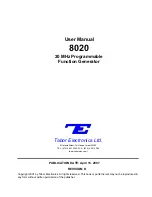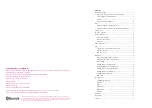
204
Transmission Modes
WAVECOM Decoder W74PC, W-PCI/e, W-CODE, W-CLOUD Manual V9.1.0
NMT-450
NMT-450 is an analogue mobile telephone system, developed by the Telecommunication Administrations
of Denmark, Finland, Norway and Sweden. The idea was to establish a compatible, automatic, public mo-
bile telephone system in the Nordic countries.
Parameter
Value
Frequency range
VHF/UHF (450 MHz)
Operation modes
Duplex FEC TDMA
Modulation
FM, SUB FFSK
Symbol rate
1200.0 Bd
Center frequency
1500 Hz
Receiver settings
FM BW = 12 kHz
Input format(s)
AF, IF
NMT-450 mobile station signals can be found from 453 MHz to 457.5 MHz, base station signals from 463
MHz to 467.5 MHz. The frequency range is divided into 180 channels of 25 kHz each (channel 1 -180).
In areas with a lot of mobile subscribers, an extended band from 452.5 MHz - 452.975 MHz (mobile) and
462.5 MHz - 462.975 MHz (base) may be used as an option. The offset between mobile and base frequen-
cy is always 10 MHz.
Control messages (signals) containing system wide information, assignment, status and dialed number are
exchanged between the mobile station and the base station.
All signals are transmitted at 1200 Bd FFSK with a center frequency of 1.5 kHz and a shift of 600 Hz.
An encoded NMT-450 frame has a length of 166 bits. Every frame contains 15 bits bit sync sequence fol-
lowed by an 11 bits frame sync sequence. The last 140 bits contains the encoded message. In order to
combat errors on the radio path, due fading and interference, an error-correcting code is used.
Today, NMT-450 is used in Sweden and a modified NMT-450 in Poland and Eastern Europe. More infor-
mation can be found in the NMT DOC 450-1 / 450-3 specifications.
NOAA-GEOSAT
The NOAA-GEOSAT software has been specifically tailored to the transmissions of meteorological satellites.
Transmissions are always at 120 rpm using an IOC of 576. In contrast to short-wave stations which use
frequency modulation, satellite weather images are transmitted using amplitude modulation.
Parameter
Value
Frequency range
VHF/UHF
Operation modes
Broadcast
Modulation
FM, SUB AM
Center frequency
1800 Hz
Speed
120 RPM, IOC=576
Receiver settings
FM, BW = 40 kHz
Input format(s)
AF, IF
The software is started in free-run mode by enabling the mode. Because this mode has no synchronization
sequence the correct display of the image is controlled by using the
Phase
function in the
Options
menu.
The special items
AM-Gain
and
AM-Offset
are placed in the
Demodulator
menu. Centering of the signal
deviations on the bar graph is controlled by adjusting
AM-Offset
. In addition maximum deviation is re-
quired on the bar graph. This is done by adjusting
AM-Gain
. It should be noted that these two adjust-
ments are influenced by each other.
















































